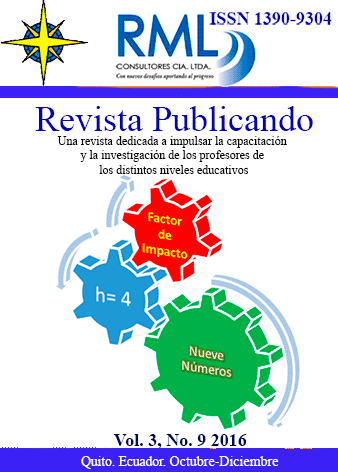Resumen
El artículo tuvo como objetivo el detallar los factores que dificultan la aplicación del pensamiento crítico y señalar las posibles líneas de investigación que puedan ser de interés en este. Se partió de una revisión bibliográfica en Scopus en relación con los términos: “critical thinking” en el titulo de los artículos y “critical thimking” en el título del documento y “education” en las palabras claves. En el primero de los caso se obtuvieron un total de 433 documentos, entre los años 2004-2015, En el segundo se obtuvieron un total de 64 documentos, entre 2005-2015.
El análisis de las tendencias de las publicaciones encontradas reveló que el pensamiento crítico es una temática de interés no sólo para la educación sino en otras disciplinas. Se discutieron las dificultades para la aplicación del pensamiento crítico en la Educación, entre ellas las relacionadas con el cumplimiento de los estándares del pensamiento crítico y aquellas que vienen dadas por la forma actual de evaluación. Como líneas de investigación de importancias se señalaron: bases conceptuales y filosóficas del pensamiento crítico, estrategias pedagógicas para la aplicación del pensamiento crítico en los distintos niveles y asignaturas y aplicación de técnicas de mapeo y visualización.
Referencias
Aizikovitsh-Udi, E. (2011). Developing critical thinking through probability models Critical thinking (pp. 69-95).
Bailin, S., Case, R., Coombs, J. R., et al.Daniels, L. B. (1999). Conceptualizing critical thinking. Journal of curriculum studies, 31(3), 285-302.
Celuch, K., et al.Slama, M. (1999). Teaching critical thinking skills for the 21st century: An advertising principles case study. Journal of Education for Business, 74(3), 134-139.
Elder, L., et al.Paul, R. (2001). Critical thinking: Thinking with concepts. Journal of Developmental Education, 24(3), 42.
Elliott, C. T., S. (2005). Critical thinking in human resource development: An introduction Critical thinking in human resource development (pp. 1-7).
Giuseffi, F. G. (2015). Ancient thinking and modern challenges: Socratic education in the 21st century Handbook of research on advancing critical thinking in higher education (pp. 1-20).
Gorman, J., et al.Heinze-Fry, J. (2014). Conceptual mapping facilitates coherence and critical thinking in the science education system Cases on teaching critical thinking through visual representation strategies (pp. 296-334).
Halpern, D. F. (2006). The nature and nurture of critical thinking Critical thinking in psychology (pp. 1-14).
Kalyuga, S. (2014). Critical thinking: A cognitive load perspective Critical thinking and higher order thinking: A current perspective (pp. 245-257).
Kirby, M. S. (2014). The use of critical thinking in journalism: Where does it start? Critical thinking and higher order thinking: A current perspective (pp. 165-173).
Lane, D., et al.Oswald, F. L. (2016). Do 45% of college students lack critical thinking skills? Revisiting a central conclusion of academically adrift. Educational Measurement: Issues and Practice, 35(3), 23-25.
Lau, J. Y. F. (2011). An introduction to critical thinking and creativity: Think more, think better.
Lau, J. Y. F. (2015). Metacognitive education: Going beyond critical thinking The palgrave handbook of critical thinking in higher education (pp. 373-389).
Lodge, J. M., O'Connor, E., Shaw, R., et al.Burton, L. (2015). Applying cognitive science to critical thinking among higher education students The palgrave handbook of critical thinking in higher education (pp. 391-407).
Moon, J. (2007). Critical thinking: An exploration of theory and practice.
O'Connell, R. M. (2014). Mind mapping for critical thinking Cases on teaching critical thinking through visual representation strategies (pp. 354-386).
Paul, R., et al.Elder, L. (1999). Critical thinking: Teaching studens to seek the logic of things, part ii. Journal of Developmental Education, 23(2), 34.
Pithers, R. T., et al.Soden, R. (2000). Critical thinking in education: A review. Educational research, 42(3), 237-249.
Stobaugh, R. (2013). Assessing critical thinking in elementary schools: Meeting the common core.
Torres, P. L., Kucharski, M. V. S., et al.de Cássia Veiga Marriott, R. (2014). Concept maps and the systematization of knowledge Cases on teaching critical thinking through visual representation strategies (pp. 494-514).
Vince, R. (2005). Ideas for critical practitioners Critical thinking in human resource development (pp. 26-36).
Wallace, B. (2014). Using the whole brain to develop thinking and problem-solving: Tasc - thinking actively in a social context Critical thinking and higher order thinking: A current perspective (pp. 51-72).
Whyte, J. (2012). Human rights: Confronting governments?: Michel foucault and the right to intervene New critical legal thinking: Law and the political (pp. 11-30).
Usted es libre de:
Compartir — copiar y redistribuir el material en cualquier medio o formato
Adaptar — remezclar, transformar y construir a partir del material
La licenciante no puede revocar estas libertades en tanto usted siga los términos de la licencia
Bajo los siguientes términos:
Atribución — Usted debe dar crédito de manera adecuada, brindar un enlace a la licencia, e indicar si se han realizado cambios. Puede hacerlo en cualquier forma razonable, pero no de forma tal que sugiera que usted o su uso tienen el apoyo de la licenciante.
NoComercial — Usted no puede hacer uso del material con propósitos comerciales.
CompartirIgual — Si remezcla, transforma o crea a partir del material, debe distribuir su contribución bajo la lamisma licencia del original.
